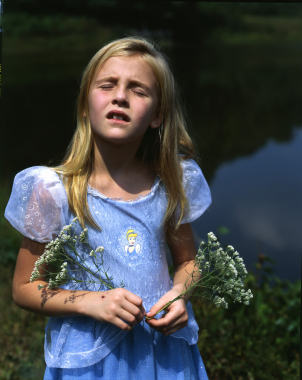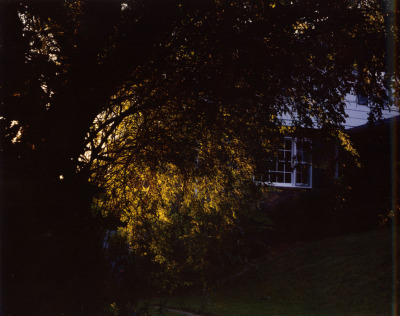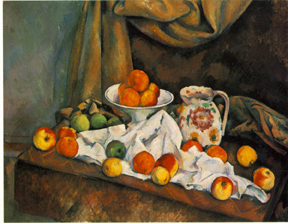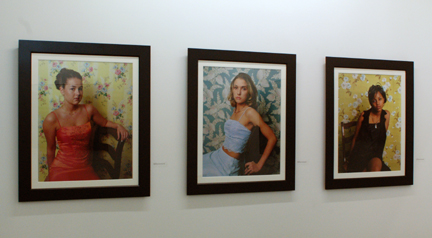The attempt to photograph life in the south is not a new idea. Life for southerners and the characters the place makes them creates jerky flavored targets and meals for literature, film, and the saltiest of still images. It is a swarming breeding ground for nostalgia and ghost stories, as a balmy, pink, and protracted humanity thickens the waterlogged atmosphere there. Thus the proliferation of films, the wide reaching fame of southern authors, the bent of the blues, and the desire to make pictures that reify what it means to exist there abound. Obviously, to do well what has been attempted by so many and so endlessly is not an easy task. One might even call it dangerous. The south has almost as many icons and clichéd booby traps as a love poem. This makes Angela West's collection of photographs at Quality Pictures this month a rather intriguing discussion. It is not that West's work delves into subjects that have not been discussed; she echoes an ache of what is still odd and difficult about life there: the expectations of gender and the strange aesthetics that dominate everything with the force of a fascist. Yet it is the way in which she does this that gently subverts the subject matter into being more real somehow, as if she took all the elements and tilted them slightly, turned them around, and when she did this, everything became evident in a way that revealed a new truth.
The first image we see as we step into the gallery is the "Princess in Peril #1".

"Princess in Peril #1" 2006 Angela West image courtesy Quality Pictures
This image is startling, as open as the child herself. She reveals everything to us, and we delight in the ability to study someone whose eyes are closed, endlessly, unabashedly, unbeknownst to them. Our conditioning cannot reign when someone's eyes are closed, and we become hypnotized, immobilized in a rare, unfettered looking. It is a spell binding image, the openness of this child. She is unafraid and reactionary in a pure way. The sun is too bright; thus she squints. Her eyes close. She does not carry yet too much of the weight of what she should be. This is her unfortunate and ironic peril, her only self preservation being an instinctual reaction against natural elements, not against human society. The second image of the young princess depicts her alone by a wide creek, the landscape engulfing and dwarfing her small self. She seems too small to be any match for these woods.
The next element of the southern recipe, the warm and sun soaked woods, are compositionally telling images. West depicts this element either as ephemeral and slightly awkward periphery or universe. In many ways these shots exhibit most blatantly West's compositional maneuvers in subverting her subject matter. The image "The Westmorelands' House" has the suburban house hiding in the shadow of dusk, barely visible, behind a dramatically backlit tree branch engulfing the majority of the picture plane.

"The Westmoreland's House" 2006 Angela West
The way West composes this shot seems to reference Cezanne's theories on the way we see as our bodies and eyes move through space. This shot feels as if one were walking past this house, the sunlight briefly attracting the brain and entering either the peripheral vision or a quick glance. To Cezanne, this was more an image of reality. These are images experienced through existing in a space.

"Compotier, Pitcher, and Fruit (Nature Morte) 1892-1894 Paul Cezanne
"Untitled Landscape #9 (Green)" is another version of the same concept of all of these photographs. They all seem too close to get any perspective, and one becomes engulfed in them atmospherically, as in being there.
This is what this image feels like, as it is an unusual photograph. This is the summary of West's compositions and why they are subversive. The two images of corsages exhibits this Cezanny, binocular, pre-cubistic attitude as well. Cubism attempted to show what existed but was not depicted. The "Homecoming 1988" photographs are silhouettes of lace and glowing pink innards of petals that are only shadows. The dark, sharp pins are what the wearer experiences, those pointy darts are the thing that lies next to the soft skin of the bosom, underneath shadows of pink keepsakes, tawdry souvenirs that somehow mean too much. Between these metaphorical pink spindles is the green of "Dad with Machete". He stands between these delicate, sharp symbols, the cause and protector, the essence of a seasoned masculinity standing guard between the pricking of young skin and virgin forest, menacingly brandishing a sword. This idea almost seems a bit classically comical, yet is still a visually savvy foil. The endless layers of influence that seem to form the strata of identity in this place are baffling, yet provide a gracefully logical background to West's portraits.
The four young women sitting for us in this gallery portray a complex visual experience of the nascent efforts to sculpt an individual femininity in a rather ideologically homogenous society. Within their mere sitting they succumb, react, and attempt soulful triumph in spite of themselves. They are telling, complex barbies. West titles each portrait "Sweet Sixteen #. . ." . It is difficult to believe these young women are only 16. They are tough, pinched, attitudinally angry or wanting.

Installation view Quality Pictures 2007
There is a weariness to their faces, an experience behind their eyes which is imbued in the forcing of their physicality. All of the primping seems to have ironically taken their youth and sullied, rather than enhance, its glow. There is nothing natural about them save the emotions revealed through their gaze. Dissatisfaction, anger, suspicion, triumphant fearlessness simmer under lacquer and beauty supply. These portraits are phenomenally strong as illustrations of identity sought and imposed. They exhibit so much of these young women. Everything about their characters is raw and tenacious; they are at once deep and feeling young people peeking through lip gloss waterfalls and a self tanned mist. Their souls survive Texas Chainsaw Massacre style. Somehow, West portraits of these belles do not come off as cliched images of young women. The line between what these photographs could be and what they are is tenuously thin. Images of young women and girls are probably the most prolific images in the world. The archetype of the ideal woman and how young girls and women are portrayed the majority of the time is so indelibly strong and ingrained that even the most respected artists unintentionally portray them as the stereotypical sexy, desired, virgin stakes, waiting and wanting to be claimed. The raw opposites are of course explored and subverted but often seem rather reactionary. Yet West is not subverting these ideas with their opposites, nor working within the parameters of the identity of the "southern woman" in order to flip it over or comment upon it with snark or derision. She takes portraits of these young women as people in the midst of all of the imposition. In the middle of the meringued coifs, individual characters emerge, each one a salty entity. Of course West's photographs are still sexy and beautiful, and something to be desired by an audience. Yet they maintain their personas, emoting to the camera, despite the narrowest of parameters.
West does the south well. She depicts particulars with a common yet subverted vocabulary and makes it interesting. The stories she tells are personal but symbolically wide reaching. Perhaps this is very much the southern tradition in her work. Hopefully, the future will hold more thorough looks at this artists' body of work for Quality Pictures' space. Her work makes real the infinite possibility of invention within story, the pictures existing in the scraped space of human experience that does not allow the work to fall back on itself or crumple inward with the weakness of an unfounded architecture. West is truth and nails, gently carving space out for herself between heavy tradition and salted booby traps.





















